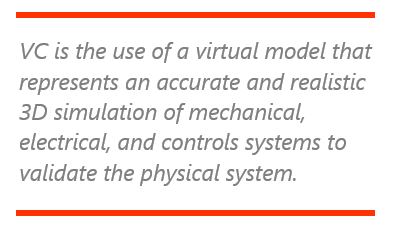

Virtual commissioning (VC) technology has been in place for at least a decade or more. It has allowed manufacturing and controls engineers to virtually simulate manufacturing production systems and validate that the physical packaging machines, conveyance systems, automotive production systems, robotic work cells, and controls (PLCs, drives, motors, sensors) all physically function as designed and built when the switch is turned on. Additionally, by using VC simulation tools, engineers can validate that components in the production system are synchronized, controlled, and will function in harmony to operate as designed.
Virtual commissioning involves the use of a virtual model that represents an accurate and realistic 3D simulation of mechanical, electrical, and controls systems to validate the physical functions of a production system prior to actual physical implementation. The inherent 
The initial virtual commissioning applications emerged as part of the overall digital manufacturing portfolios offered by product lifecycle management (PLM) suppliers. Here, 3D CAD models of machines, robotic work cells, and production systems could be created and used to virtually simulate motion and production functions. The other part of VC was to create software that would emulate the control systems (PLCs, robots, etc.) to be able to virtually test the physical system. Today, we are seeing the convergence of traditional VC with the more recent emergence of the concept and implementation of the digital twin.
From its inception, virtual commissioning has always been intended to help solve a variety of issues that can arise when production systems require integration and operational functionality using automation and control hardware such as programmable logic controllers (PLCs), motion controllers, robotics (kinematics), and other controls equipment. The automation industry has long acknowledged the benefits of using virtual models to simulate the performance of physical systems to enable integration issues to be identified before entering the time-consuming and expensive process of physical commissioning. To successfully implement VC, however, the virtual factory model must be an accurate representation of the system. While these types of simulation models were used with some success in the aerospace and automotive industries, this was not the case in the overall automation market.
Significantly, these technologies can be used remotely. That is, in the connected and intelligent environment of today’s Industrial IoT-connected world; production systems, machines, and equipment in the field can be integrated, tested, and validated virtually and remotely in lieu of physical testing by engineers in the field.
Controls engineers and automation researchers have organized four categories of general controls development:
The actual virtual commissioning process is usually an iterative approach using MiL, SiL, and HiL concurrently. Once the MiL is complete, controls engineers use SiL testing to verify that the logic in the model is consistent once it has been compiled into machine code. If no errors are found at this stage, final HiL testing is conducted by compiling the software onto the physical PLC or HMI. Today, suppliers of robust VC development and simulation platforms typically provide a full range of simulation and VC applications that meet this approach.
What we are seeing today is the convergence of established virtual commissioning technology with the more recent emergence of the concept and implementation of the digital twin across industry and business. While VC represents the simulation and modeling of machines and production systems to virtually validate the system and the controls that automate it, the concept of the digital twin is broader in scope and involves capturing sensor data from physical machines and systems in operation and using that data to create simulations in real time. Moreover, VC is the initial step in bringing a production system to operation and is a part of the overall digital twin process. Because of its real-time characteristics, a digital twin can simulate a system while it is operational. This allows manufacturers to monitor the system, create models for adjustments, and make changes to the system.
The implementation of a digital twin enables the optimization of each phase of the production process. Capturing sensor data throughout the functional components of the system provides essential feedback, enables predictive and prescriptive analytics, and minimizes unplanned downtime. Additionally, VC works in conjunction with the digital twin process by validating the operation of the controls and automation functions and providing the baseline operation of the system.
ARC Advisory Group clients can view the complete report at ARC Client Portal
If you would like to buy this report or obtain information about how to become a client, please Contact Us
Keywords: Digital Twin, Model-Based Design (MBD), Virtual Simulation, Automation and Controls, Emulation, Hardware-in-the-Loop (HiL), Systems Design, ARC Advisory Group.

